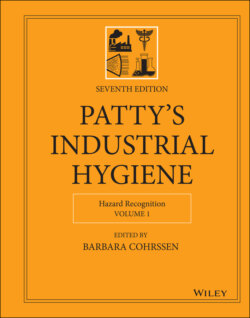Читать книгу Patty's Industrial Hygiene, Hazard Recognition - Группа авторов - Страница 17
2.2 1930s: The Emergence of Industrial Hygiene as a Profession
ОглавлениеBy the 1930s, medical doctors, engineers, and others with relevant skills in industrial hygiene practice had begun working more closely together. The early field studies beginning generally in the 1930s showed that when the very high exposures of workers were lowered, there was a corresponding lowering of the related disease incidence in workers. These and other studies gave support to the dose–response rationale upon which the practice of industrial hygiene is primarily based, that is, that there is a dose–response relationship between the extent of exposure and severity of biological response to most stressors and in which the response is observable at some point.
For example, the first major development in the industrial hygiene history of asbestos occurred in 1930 when Merewether (a medical doctor) and Price (an engineer with occupational hygiene skills) of the British Inspector of Factories, published a significant study on asbestosis in the asbestos textile manufacturing industry (18),(19). This publication served as the first analysis that showed a relationship between the airborne concentration of asbestos and the incidence of pulmonary fibrosis disease. The basic industrial hygiene control methods that are still standard today were identified by Merewether and Price (18) and were incorporated into the first regulations that became effective in 1932 to limit factory worker exposure to asbestos in Great Britain (20).
The Hawks Nest Tunnel disaster in the 1930–1934 time period was a major event in increasing attention to industrial hygiene and occupational disease in the United States. In 1936, the US House of Representatives attributed 476 deaths to acute silicosis primarily from the drilling operations for the tunnel (21). By the late 1930s, the profession of industrial hygiene was emerging in the United States. In a 1937 book authored by medical doctors Ling and Nixon and printed in Great Britain, it was noted as the first sentence that “Industrial hygiene has in recent years come to assume an important place in both medicine and in industry” (22). In the United States, the Social Security Act of 1935 and the Walsh–Healy Act of 1936 had an immense impact on providing increased stability, incentive, and expanded focus in the practice of industrial hygiene. These Acts largely stimulated the creation of industrial hygiene programs in industry, foundations, educational institutions, insurance carriers, labor unions, and government that addressed the causes, recognition, and control of occupational diseases and incorporation of these programs as an integral part of management. These Acts established the philosophy that the worker had a right to earn a living without endangerment to health and were the forerunners for the passage of the Occupational Safety and Health Act (OSHAct) of 1970.
In the US, the impact of Social Security funding significantly aided the development of the industrial hygiene profession in the 1930s. For example, studies similar to those of Merewether and Price were conducted in the United States later in the 1930s; notably, one in 1938 by the USPHS that established the first airborne standard for asbestos dust and provided important information on the effectiveness of engineering controls in the workplace such as ventilation systems . This USPHS‐funded study was noted as one of the first uses of the newly available Social Security funds in the United States.
The establishment of professional associations to support the interests and growth of the profession has also played an important role in developing industrial hygiene as a science. The Michigan Industrial Hygiene Society (MIHS) and the American Conference of Governmental Industrial Hygienists (ACGIH) were founded in 1938. The American Industrial Hygiene Association (AIHA) was organized in 1939 and held its first annual conference that year and every year thereafter except 1945 (26).
Beyond those working in the USPHS, there were few industrial hygiene professionals in the United States in the 1930s, with a count by MIHS noting 160 members of AIHA as of 1940 with 32 or 20% in the Detroit area (26). It has been noted that Warren Cook estimated that there were only about 300 industrial hygienists in the United States in 1939 (27). One of the few industrial companies that had such capable professionals included the Standard Oil Company. The first major study of dust in the petrochemical industry was conducted by Bonsib in 1937 (28). Bonsib and his industrial safety and hygiene colleagues were clearly pioneers in such matters. Bonsib's report on such dusts predated even the first major USPHS study of the asbestos textile industry in 1938 (24). The report by Bonsib included measurements of at least 17 different kinds of dust but was generally focused on silica dust.
